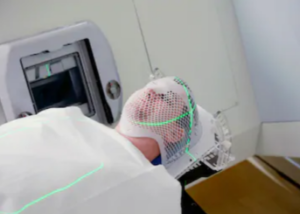Glioblastoma brain cancer is actually the most common type of malignant brain tumor in adults, and the prognosis is grim.
“He’s finished,” one might think upon learning that someone has this very high grade cancer.
This type of brain tumor is also commonly known as glioblastoma multiforme.
It’s aggressive and merciless.
Incidence of Glioblastoma Brain Cancer in the U.S.
• 3.19 per 100,000 people according to Cancer Epidemiology, Biomarkers and Prevention (July 22, 2014); and 4.67 to 5.73 per 100 000 (Neuro-Oncology, July 2014).
• Average age of diagnosis is 64
• Can strike any age; 1.1 to 3.6 per 100 000 infants (Contemporary Oncology, 2014)
• More common in men than women: 1.26 cases to 1, and 3.3 to 1 for infants (Contemporary Oncology, 2014)
• Average survival rate with treatment after diagnosis is 15 months.
• Five year survival rate with treatment is less than five percent.
Glioblastoma Brain Cancer Symptoms
The American Association of Neurological Surgeons lists the following symptoms.
• Persistent headaches
• Blurred or double vision
• Loss of appetite
• Vomiting
• Personality or mood changes
• Cognitive impairment
• New-onset seizure
• Gradual onset of speech difficulty
Why is a GBM so lethal?
Glioblastoma is particularly difficult to treat due to several factors.
Firstly, its highly aggressive nature makes it one of the most rapidly growing and invasive brain tumors.
The tumor cells infiltrate surrounding brain tissue, making complete surgical removal difficult (National Brain Tumor Society, 2020).
Additionally, glioblastomas often exhibit resistance to standard treatments like radiation and chemotherapy.
This resistance is partly due to the tumor’s heterogeneous cellular composition and the presence of a blood-brain barrier that limits the effectiveness of many drugs (American Brain Tumor Association, 2021).
Furthermore, glioblastoma cells can develop multiple mechanisms to evade the immune system and repair themselves after medical treatment (Cancer Research UK, 2022).
Breakthrough Can Extend Life for GBM Patients
A study from Keck Medicine of USC may offer new hope regarding glioblastoma.
Researchers have found that combining three different types of therapy may significantly extend patients’ lives.
The treatment involves using tumor treating fields (TTFields), a device that sends mild electric fields into the brain to interfere with cancer cell growth.
When used together with chemotherapy and a form of immunotherapy called pembrolizumab, this combination appears to give patients more time.
How It Works
TTFields uses low-level, alternating electric waves to disrupt cancer cell division.
The painless waves are delivered through soft mesh patches on the scalp, which patients wear for about 18 hours a day.
The electric fields target only the tumor without harming surrounding healthy brain tissue.
On their own, these electric fields help slow down or stop tumor growth.
But in this study, scientists found they helped trigger the body’s immune system to attack the tumor.
The fields attracted the immune system’s T cells into the area around the tumor.
Once these immune cells were present and active in the tumor, the addition of immune-system-boosting pembrolizumab helped them work even better.
The Results
The new combination therapy led to a 70% improvement in how long patients lived, compared to earlier patients who received only TTFields and chemotherapy.
The treatment worked best against large tumors that couldn’t be removed through surgery.
These patients, who usually have the worst outlook, showed the strongest immune response and lived the longest.
Bigger tumors may provide more “targets” for the electric fields and the immune system to work on.
When the tumor is left in place, it may trigger a stronger immune response — something that surgery might accidentally reduce by removing much of the tumor material the immune system would otherwise recognize.
To test this, researchers launched a clinical trial involving 31 patients with newly diagnosed glioblastoma.
All had already completed radiation treatment.
Of those, 26 received the full treatment: TTFields, chemotherapy and immunotherapy.
Seven of these patients had inoperable tumors.
The full treatment in the Keck study lasted up to two years, depending on how well each patient tolerated the therapy.
On average, patients who received all three treatments lived about 10 months longer than those who had previously received TTFields and chemotherapy alone.
Those with inoperable tumors lived about 13 months longer.
As of summertime 2025, Keck Medicine is participating in a larger Phase 3 trial that will include over 740 patients at sites in the U.S., Europe and Israel.










































